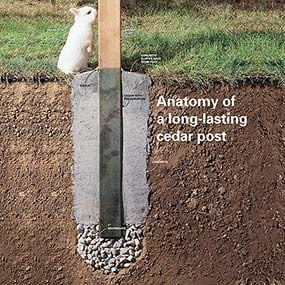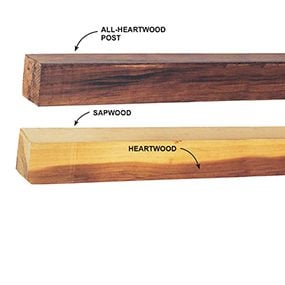Cedar fencing is an extremely popular choice of wood for fencing and also could possibly be the perfect lumber for any fencing projects. Cedar fencing is becoming much more widely used because they are biologically termite repellent additionally they usually do not degrade from wet conditions and also wind. This high quality of theirs tends to make cedar fencing probably the most practical choices for landscape fencing. Cedar fencing is an obviously stylish option for level of privacy and also security.
How to Set Fence Posts That Won’t Rot
How to install cedar fence posts that last.  Anatomy of a long-lasting fence post
Anatomy of a long-lasting fence post
This photo shows the five ways to make your wooden fence posts last a long time.
“Please see an enlargement in additional information below.”

Pick the right posts
Don’t use posts that contain sapwood. Instead, use heartwood, because it’s denser and more insect-resistant.

Treat the post with preservatives
Soak the bottom of the wooden fence posts in a wood preservative containing copper napthanate, such as Cuprinol.

Caulk around the fence post base
Apply high-quality exterior acrylic latex caulk, or silicone specifically designed to adhere to concrete to prevent moisture penetration, at the base of the post.
If your cedar wooden fence posts are rotting at the bottom, you need to replace them. The rot probably developed because the posts were installed improperly. So if you install your new posts the same way the old posts were installed, you’ll just have to do the whole thing over again a few years down the line.
Cedar has a reputation for durability, but unless a few guidelines are followed, cedar posts can fail in as few as five years. Three factors contribute to this early failure: poor drainage, low-quality wood and poor protection against insect damage. To get the most out of your new posts, here are five things you can do:
1. Soak the bottom of the posts in a wood preservative containing copper napthanate, such as Cuprinol. Available at some paint stores and home centers, this wood treatment is specifically designed for in-ground applications.
2. Place about 6 in. of aggregate in the bottom of the posthole to allow for drainage. The bottom of the post should extend a few inches into the aggregate as shown.
3. Pour the concrete so that it’s above the soil level. Trowel the top smooth and slope it so that water runs away from the post.
4. Apply high-quality exterior acrylic latex caulk, or silicone specifically designed to adhere to concrete, at the base of the post. This will seal the gap between the concrete and post that’s caused by freeze/thaw cycles.
5. Don’t use posts that contain sapwood. Sapwood is lighter in color (usually yellow) than heartwood, which is dark. Instead, use heartwood, because it’s denser and more insect-resistant.
Additional Information Anatomy of a long-lasting fence post Required Tools for this Project
Have the necessary tools for this DIY wooden fence post project lined up before you start—you’ll save time and frustration. BucketCaulk gunPaintbrushPosthole diggerShovelTrowelWheelbarrow
Required Materials for this Wooden Fence Post Project
Avoid last-minute shopping trips by having all your materials ready ahead of time. Here’s a list. AggregateCementExterior acrylic latex caulkWood preservative
Wood rot always starts with a source of water, if only just a slight dribble during a hard rain, contacting raw wood. Starting with the best water resistant woods is the best practice. We see the lack proper protection from wood rot from water penetration all too often. If you have moisture damaged wood in your home, give us a call.
Water Damage Restoration Pros – Orange County
982 N Batavia St, Orange, CA, 92867
1 (844) 234-0305
1





